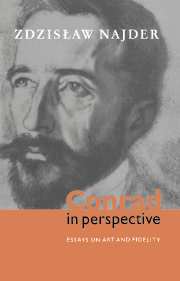Book contents
- Frontmatter
- Contents
- Acknowledgements
- Note on the texts
- List of abbreviations
- 1 Introduction, or confession of a mastodon
- 2 Conrad's Polish background, or from biography to a study of culture
- 3 Joseph Conrad's parents
- 4 Joseph Conrad and Tadeusz Bobrowski
- 5 The Sisters: a grandiose failure
- 6 Lord Jim: a Romantic tragedy of honour
- 7 The Mirror of the Sea
- 8 A Personal Record
- 9 Joseph Conrad's The Secret Agent, or the melodrama of reality
- 10 Conrad, Russia and Dostoevsky
- 11 Conrad and Rousseau: concepts of man and society
- 12 Conrad and the idea of honour
- 13 Joseph Conrad: a European writer
- 14 Joseph Conrad after a century
- 15 Joseph Conrad in his historical perspective
- 16 Fidelity and art: Joseph Conrad's cultural heritage and literary programme
- Notes
- Index
15 - Joseph Conrad in his historical perspective
Published online by Cambridge University Press: 07 December 2009
- Frontmatter
- Contents
- Acknowledgements
- Note on the texts
- List of abbreviations
- 1 Introduction, or confession of a mastodon
- 2 Conrad's Polish background, or from biography to a study of culture
- 3 Joseph Conrad's parents
- 4 Joseph Conrad and Tadeusz Bobrowski
- 5 The Sisters: a grandiose failure
- 6 Lord Jim: a Romantic tragedy of honour
- 7 The Mirror of the Sea
- 8 A Personal Record
- 9 Joseph Conrad's The Secret Agent, or the melodrama of reality
- 10 Conrad, Russia and Dostoevsky
- 11 Conrad and Rousseau: concepts of man and society
- 12 Conrad and the idea of honour
- 13 Joseph Conrad: a European writer
- 14 Joseph Conrad after a century
- 15 Joseph Conrad in his historical perspective
- 16 Fidelity and art: Joseph Conrad's cultural heritage and literary programme
- Notes
- Index
Summary
Joseph Conrad was born in 1857; his first novel was published in 1895; and he died in 1924. The lapse of time since then constitutes, I suppose, a distance sufficient to see him in a historical perspective. It allows us to ask, without an excessive fear of of having our picture blurred by the closeness of the object, what is Conrad's place in the history of literature.
This issue, as I see it, involves three groups of questions: what were the traditions, intellectual and artistic, which nursed Conrad's creative talent? What was the position of his work within contemporary spiritual and literary trends and movements? And, thirdly, who were his followers and what sort of inheritance has he left to them? Of course, within the scope of a short chapter one can hope only to open a few vistas on the problem, announced boldly in its title.
Luckily for us historians of literature, most writers, including those of the first rank, fit more or less neatly into some general pattern of artistic and intellectual life of their time. Even when ‘exceptional’, ‘outstanding’ and ‘breaking new ground’ they allow themselves to be arranged in groups and sequences. They loyally contribute to the ‘temper of the era’, allowing us to draw dividing lines between periods and to talk about typicality and representativeness. Occasionally, however, we encounter figures so peculiar, so aberrant, that it is virtually impossible to fit them into the general formula of their time. Conrad seems to be a good candidate for the first place among these freaks.
He published his most important books between the years 1897 and 1911.
- Type
- Chapter
- Information
- Conrad in PerspectiveEssays on Art and Fidelity, pp. 188 - 198Publisher: Cambridge University PressPrint publication year: 1997



